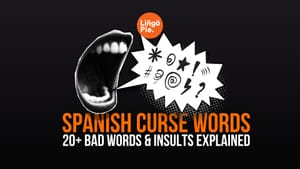Math might be considered a universal language, but that doesn’t mean you can skip the vocabulary. Whether you're studying abroad, helping kids with homework, collaborating on a project, or just ordering groceries in Latin America, knowing math in Spanish helps you build fluency and confidence.
And it’s not just about numbers—you’re also sharpening your understanding of how the Spanish language is used in real-world situations. To help you, this guide covers the basic terms for math in Spanish, starting from common symbols and moving into algebra, geometry, and beyond.

Basic Spanish Math Vocabulary
You can use either matemática (singular) or matemáticas (plural). Both are correct and choosing one often depends on regional preference.
- Juan loves math. – A Juan le encantan las matemáticas.
- Math wasn’t my strong suit. – La matemática no era mi fuerte.
These words show up in everyday conversation. Here's how to use some of the key terms:
- Número par (even number): Cuatro es un número par.
- Número impar (odd number): Cinco es un número impar.
- Número ordinal (ordinal number): Estoy en el tercer grado.
- Pi (π): Usamos el número pi para calcular la circunferencia.
- Contar (to count): Vamos a contar hasta veinte.
| English | Spanish |
|---|---|
| Number | El número |
| Even number | El número par |
| Odd number | El número impar |
| Prime number | El número primo |
| Ordinal number | El número ordinal |
| Decimal number | El número decimal |
| Pi | El número pi |
| The point (decimal) | La coma |
| Operations | Las operaciones |
| The solution | La solución |
| Arithmetic | La aritmética |
| Algebra | El álgebra |
| Geometry | La geometría |
| Calculus | El cálculo |
| Greater than | Mayor que |
| Less than | Menor que |
| To count | Contar |
| To measure | Medir |

Spanish Math Symbols
Spanish math symbols are the same as in English, but the way they're described and used in sentences can vary a bit.
- Dos más dos es cuatro. (2 + 2 = 4)
- Cinco menos uno es cuatro. (5 - 1 = 4)
- Tres por tres son nueve. (3 × 3 = 9)
- Doce dividido entre cuatro es tres. (12 ÷ 4 = 3)
| Symbol | English Term | Spanish Term |
|---|---|---|
| + | Plus | Más |
| - | Minus | Menos |
| × | Times | Por |
| ÷ | Divided by | Dividido entre |
| % | Percent | Por ciento |
| √ | Square root | La raíz cuadrada |
| x² | X squared | X al cuadrado |
| = | Equal | Igual |
| ≠ | Unequal | Desigual |
| ( ) | Parenthesis | Los paréntesis |
| { } | Brackets | Las llaves |
| / | Fraction slash | La barra de fracciones |
| < | Less than | Menor que |
| > | Greater than | Mayor que |
| ≤ | Less than or equal to | Menor o igual a |
| ≥ | Greater than or equal to | Mayor o igual a |
| ° | Degrees | Los grados |
Let's say you see a price tag that says "10,50 €". In Spain and Latin America, the comma is the decimal point. How would you say that price out loud? → Diez con cincuenta euros.

Algebra Terms in Spanish
These terms help describe relationships between values and are used often in school settings.
- La suma de cinco y tres es ocho. (The sum of five and three is eight.)
- Una ecuación es una expresión con una igualdad. (An equation is an expression with an equal sign.)
- Una variable puede cambiar de valor. (A variable can change value.)
- Los polinomios contienen términos con variables y constantes.
| English | Spanish |
|---|---|
| Addition | La suma |
| Subtraction | La resta |
| Multiplication | La multiplicación |
| Division | La división |
| Percentage | El porcentaje |
| Equation | La ecuación |
| Monomial | El monomio |
| Binomial | El binomio |
| Polynomial | El polinomio |
| Trinomial | El trinomio |
| Factoring | La factorización |
| Terms | Los términos |
| Variable | La variable |
| Constant | La constante |
| Exponent | El exponente |
| Functions | Las funciones |
| Cosine | El coseno |
| Sine | El seno |
| Logarithm | El logaritmo |
| Sequences | Las secuencias |
| Series | Las series |
| Binary | Binario |
| Graph | El gráfico |
| Matrix | La matriz |
| Vector | El vector |
How do you say: “Four times five equals twenty”?
Cuatro por cinco es igual a veinte.
Geometry Terms in Spanish
These words are useful for shapes, sizes, and spatial reasoning. Here's how they come up in conversation:
- Un triángulo tiene tres lados. (A triangle has three sides.)
- El diámetro del círculo es dos veces el radio. (The diameter of the circle is twice the radius.)
- Calcula el perímetro del rectángulo. (Calculate the rectangle's perimeter.)
| English | Spanish |
|---|---|
| Geometric shapes | Las figuras geométricas |
| Square | El cuadrado |
| Rectangle | El rectángulo |
| Circle | El círculo |
| Triangle | El triángulo |
| Diamond | El rombo |
| Trapezoid | El trapecio |
| Pentagon | El pentágono |
| Hexagon | El hexágono |
| Dodecahedron | El dodecaedro |
| Parallelogram | El paralelogramo |
| Pyramid | La pirámide |
| Sphere | La esfera |
| Cone | El cono |
| Cylinder | El cilindro |
| Circumference | La circunferencia |
| Radius | El radio |
| Diameter | El diámetro |
| Perimeter | El perímetro |
| Area | El área |
| Surface | La superficie |
| Hypotenuse | La hipotenusa |
| Leg (triangle) | El cateto |
| Base | La base |
| Height | La altura |
| Angle | El ángulo |
| Right angle | El ángulo recto |
| Obtuse angle | El ángulo obtuso |
| Acute angle | El ángulo agudo |
| Reflexive angle | El ángulo reflexivo |
| Concave | Cóncavo |
| Convex | Convexo |

Other Spanish Math Terms
These terms are often seen in higher-level math or technical discussions.
- El promedio de 3, 4 y 5 es cuatro. (The average of 3, 4, and 5 is four.)
- La derivada mide el cambio instantáneo. (The derivative measures instantaneous change.)
- El cociente es el resultado de una división. (The quotient is the result of a division.)
| English | Spanish |
|---|---|
| Average | El promedio |
| Derivative | La derivada |
| Gradient | El gradiente |
| Integral | La integral |
| Interval | El intervalo |
| Principle | El principio |
| Probability | La probabilidad |
| Pythagorean theorem | El teorema de Pitágoras |
| Quotient | El cociente |
| Result | El resultado |
| Rotation | La rotación |
| Segment | El segmento |
| 3D | Tridimensional |
| 2D | Bidimensional |
| Unit | La unidad |
| Value | El valor |
Practice Dialogues In Spanish
These short, structured dialogues are designed to show you how math vocabulary works in everyday Spanish. You can practice these with a tutor, language partner, or by reading them out loud.
Each one highlights common situations where math terms appear naturally.
1. At the Grocery Store
— ¿Cuánto es cinco por tres?
— Quince pesos.
(How much is five times three? Fifteen pesos.)
2. Helping with Homework
— ¿Qué es un número impar?
— Es un número que no se puede dividir en dos partes iguales, como el cinco.
(What’s an odd number? It’s one that can’t be split into two equal parts—like five.)
3. Talking About the Weather
— ¿Qué temperatura hace?
— Hoy estamos a treinta y dos grados.
(What’s the temperature? It’s 32 degrees today.)
4. In Class
— ¿Cuál es la solución de esta ecuación?
— Es x igual a cuatro.
(What’s the solution to this equation? X equals four.)
5. Comparing Prices
— Este cuesta más.
— Sí, es mayor que el otro.
(This one costs more. Yeah, it’s more than the other one.)
Final Thoughts
Now you’re equipped with everything you need to talk about math in Spanish—from basics like suma and número impar, to geometry, algebra, and even calculus.
If you're just starting out, begin with numbers and simple operations. Speak them out loud as you do everyday tasks—count your change, split a bill, or explain a shape. You'll start to build comfort and confidence with math in Spanish, one phrase at a time.
Want more? Try our guides on:
- How to Conjugate the Verb ‘Tener’ in Spanish
- 100 Easy Spanish Words for Beginners
- Spanish Curse Words: 20+ Crazy Bad Words In Spanish
And if you want to actually hear how native speakers use these terms in real conversations, TV shows, or movies, check out Lingopie. It’s a fun and immersive way to boost your Spanish listening skills—especially for vocab that sticks.
FAQ
Is it 'matemática' or 'matemáticas'?
Both are correct. Matemáticas is more common in Latin America. Matemática is often used in Spain.
How do Spanish speakers read decimal numbers?
They use a comma instead of a period. For example, 3.14 in Spanish is tres coma catorce.
What's the best way to practice these terms?
Use them in real-life scenarios—talk about money, quantities, shapes, or even quiz yourself using flashcards.
What’s the difference between “por” and “para” in math?
In math, “por” is used for multiplication (e.g., cinco por cuatro). “Para” isn’t used in calculations.
How do I ask someone to repeat a number in Spanish?
Try: ¿Puedes repetir ese número, por favor? or ¿Dijiste veintitrés o treinta y tres?
What are the most common mistakes learners make?
Confusing “coma” (comma/decimal) with “punto,” or mishearing “quince” vs. “cinco.”


![Math In Spanish: A Complete Beginner’s Guide [2025]](/blog/content/images/size/w1200/2025/04/Math-in-spanish.jpg)

![How To Learn German Fast As A Beginner [Tips, Tricks, And Resources]](/blog/content/images/2025/04/Best-way-to-learn-German.jpg)


![Are You A Gabacho, Gringo, Or Güero? [Spanish Slang Guide]](/blog/content/images/size/w300/2025/06/Gabacho-Meaning.jpg)

